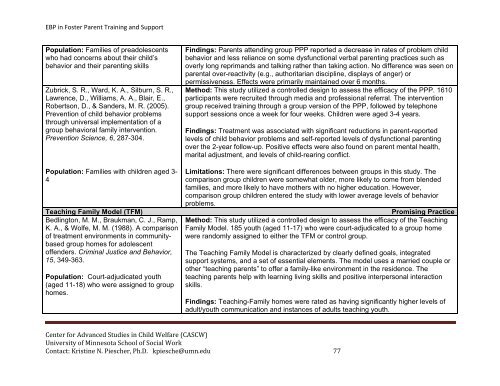Evidence-Based Practice in Foster Parent Training and Support ...
Evidence-Based Practice in Foster Parent Training and Support ...
Evidence-Based Practice in Foster Parent Training and Support ...
Create successful ePaper yourself
Turn your PDF publications into a flip-book with our unique Google optimized e-Paper software.
EBP <strong>in</strong> <strong>Foster</strong> <strong>Parent</strong> Tra<strong>in</strong><strong>in</strong>g <strong>and</strong> <strong>Support</strong>Population: Families of preadolescentswho had concerns about their child’sbehavior <strong>and</strong> their parent<strong>in</strong>g skillsZubrick, S. R., Ward, K. A., Silburn, S. R.,Lawrence, D., Williams, A. A., Blair, E.,Robertson, D., & S<strong>and</strong>ers, M. R. (2005).Prevention of child behavior problemsthrough universal implementation of agroup behavioral family <strong>in</strong>tervention.Prevention Science, 6, 287-304.F<strong>in</strong>d<strong>in</strong>gs: <strong>Parent</strong>s attend<strong>in</strong>g group PPP reported a decrease <strong>in</strong> rates of problem childbehavior <strong>and</strong> less reliance on some dysfunctional verbal parent<strong>in</strong>g practices such asoverly long reprim<strong>and</strong>s <strong>and</strong> talk<strong>in</strong>g rather than tak<strong>in</strong>g action. No difference was seen onparental over-reactivity (e.g., authoritarian discipl<strong>in</strong>e, displays of anger) orpermissiveness. Effects were primarily ma<strong>in</strong>ta<strong>in</strong>ed over 6 months.Method: This study utilized a controlled design to assess the efficacy of the PPP. 1610participants were recruited through media <strong>and</strong> professional referral. The <strong>in</strong>terventiongroup received tra<strong>in</strong><strong>in</strong>g through a group version of the PPP, followed by telephonesupport sessions once a week for four weeks. Children were aged 3-4 years.F<strong>in</strong>d<strong>in</strong>gs: Treatment was associated with significant reductions <strong>in</strong> parent-reportedlevels of child behavior problems <strong>and</strong> self-reported levels of dysfunctional parent<strong>in</strong>gover the 2-year follow-up. Positive effects were also found on parent mental health,marital adjustment, <strong>and</strong> levels of child-rear<strong>in</strong>g conflict.Population: Families with children aged 3- Limitations: There were significant differences between groups <strong>in</strong> this study. The4comparison group children were somewhat older, more likely to come from blendedfamilies, <strong>and</strong> more likely to have mothers with no higher education. However,comparison group children entered the study with lower average levels of behaviorproblems.Teach<strong>in</strong>g Family Model (TFM) Promis<strong>in</strong>g <strong>Practice</strong>Bedl<strong>in</strong>gton, M. M., Braukman, C. J., Ramp,K. A., & Wolfe, M. M. (1988). A comparisonof treatment environments <strong>in</strong> communitybasedgroup homes for adolescentoffenders. Crim<strong>in</strong>al Justice <strong>and</strong> Behavior,15, 349-363.Population: Court-adjudicated youth(aged 11-18) who were assigned to grouphomes.Method: This study utilized a controlled design to assess the efficacy of the Teach<strong>in</strong>gFamily Model. 185 youth (aged 11-17) who were court-adjudicated to a group homewere r<strong>and</strong>omly assigned to either the TFM or control group.The Teach<strong>in</strong>g Family Model is characterized by clearly def<strong>in</strong>ed goals, <strong>in</strong>tegratedsupport systems, <strong>and</strong> a set of essential elements. The model uses a married couple orother “teach<strong>in</strong>g parents” to offer a family-like environment <strong>in</strong> the residence. Theteach<strong>in</strong>g parents help with learn<strong>in</strong>g liv<strong>in</strong>g skills <strong>and</strong> positive <strong>in</strong>terpersonal <strong>in</strong>teractionskills.F<strong>in</strong>d<strong>in</strong>gs: Teach<strong>in</strong>g-Family homes were rated as hav<strong>in</strong>g significantly higher levels ofadult/youth communication <strong>and</strong> <strong>in</strong>stances of adults teach<strong>in</strong>g youth.Center for Advanced Studies <strong>in</strong> Child Welfare (CASCW)University of M<strong>in</strong>nesota School of Social WorkContact: Krist<strong>in</strong>e N. Piescher, Ph.D. kpiesche@umn.edu 77
















